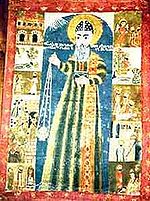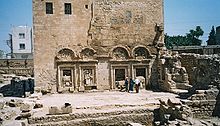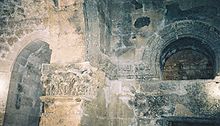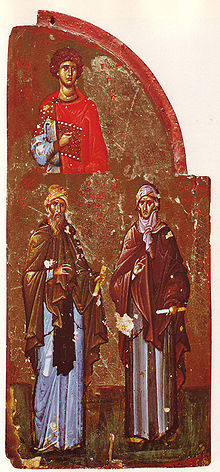- Ephrem the Syrian
-
"Ephrem" redirects here. For other persons with the name, see Ephrem (name).
Saint Ephrem the Syrian 
Icon of Ephrem the Syrian from Meryem Ana Kilisesi, DiyarbakırDeacon, Confessor and Doctor of the Church; Venerable Father Born c. 306
Nisibis (modern-day Turkey)Died 9 June 373
Edessa (modern-day Turkey)Honored in All Christianity, especially in Syriac Christianity Feast 28 January (Eastern Orthodox Church, Eastern Catholic Churches)
June 18 (Maronite Church and on some local calendars)
7th Saturday before Easter (Syriac Orthodox Church)
June 8 (Scottish Episcopal Church)
June 9 (Roman Catholic Church and Church of England)
June 10 (Church in Wales and Episcopal Church in the USA)Attributes Vine and scroll, deacon's vestments and thurible; with Saint Basil the Great; composing hymns with a lyre Patronage Spiritual directors and spiritual leaders Ephrem the Syrian (Aramaic / Syriac: ܐܦܪܝܡ ܣܘܪܝܝܐ, Mor/Mar Afrêm Sûryāyâ; Greek: Ἐφραίμ ὁ Σῦρος; Latin: Ephraem Syrus; ca. 306 – 373) was a Syriac and a prolific Syriac-language hymnographer and theologian of the 4th century.[1][2][3][4] He is venerated by Christians throughout the world, and especially in the Syriac Orthodox Church, as a saint.
Ephrem wrote a wide variety of hymns, poems, and sermons in verse, as well as prose biblical exegesis. These were works of practical theology for the edification of the church in troubled times. So popular were his works, that, for centuries after his death, Christian authors wrote hundreds of pseudepigraphous works in his name. Ephrem's works witness to an early form of Christianity in which western ideas take little part. He has been called the most significant of all of the fathers of the Syriac-speaking church tradition.[5]
Contents
Life
Ephrem was born around the year 306 in the city of Nisibis (the modern Turkish town of Nusaybin, on the border with Syria, which had come into Roman hands only in 298). Internal evidence from Ephrem's hymnody suggests that both his parents were part of the growing Christian community in the city, although later hagiographers wrote that his father was a pagan priest. Numerous languages were spoken in the Nisibis of Ephrem's day, mostly dialects of Aramaic. The Christian community used the Syriac dialect. The culture included pagan religions, Judaism and early Christian sects.
Jacob, the second bishop of Nisibis,[6] was appointed in 308, and Ephrem grew up under his leadership of the community. Jacob of Nisibis is recorded as a signatory at the First Council of Nicea in 325. Ephrem was baptized as a youth, and almost certainly became a son of the covenant, an unusual form of Syrian proto-monasticism. Jacob appointed Ephrem as a teacher (Syriac malp̄ānâ, a title that still carries great respect for Syriac Christians). He was ordained as a deacon either at his baptism or later.[7] He began to compose hymns and write biblical commentaries as part of his educational office. In his hymns, he sometimes refers to himself as a 'herdsman' (ܥܠܢܐ, ‘allānâ), to his bishop as the 'shepherd' (ܪܥܝܐ, rā‘yâ) and his community as a 'fold' (ܕܝܪܐ, dayrâ). Ephrem is popularly credited as the founder of the School of Nisibis, which in later centuries was the centre of learning of the Syriac Orthodox Church.
 Newly excavated Church of Saint Jacob in Nisibis, where Ephrem taught and ministered.
Newly excavated Church of Saint Jacob in Nisibis, where Ephrem taught and ministered.
In 337 Emperor Constantine I, who had legalised and promoted the practice of Christianity in the Roman Empire, died. Seizing on this opportunity, Shapur II began a series of attacks into Roman North Mesopotamia. Nisibis was besieged in 338, 346 and 350. During the first siege, Ephrem credits Bishop Jacob as defending the city with his prayers. In the third siege, of 350, Shapur rerouted the River Mygdonius to undermine the walls of Nisibis. The Nisibenes quickly repaired the walls while the Persian elephant cavalry became bogged down in the wet ground. Ephrem celebrated what he saw as the miraculous salvation of the city in a hymn which portrayed Nisibis as being like Noah's Ark, floating to safety on the flood.
One important physical link to Ephrem's lifetime is the baptistery of Nisibis. The inscription tells that it was constructed under Bishop Vologeses in 359. In that year Shapur attacked again. The cities around Nisibis were destroyed one by one, and their citizens killed or deported. Constantius II was unable to respond; the campaign of Julian ended with his death in battle. His army elected Jovian as the new emperor, and to rescue his army he was forced to surrender Nisibis to Persia, and permit the expulsion of the entire Christian population.
Ephrem with the others went first to Amida (Diyarbakır), eventually settling in Edessa (modern Şanlıurfa) in 363. Ephrem, in his late fifties, applied himself to ministry in his new church, and seems to have continued his work as a teacher, perhaps in the School of Edessa. Edessa had always been at the heart of the Syriac-speaking world and the city was full of rival philosophies and religions. Ephrem comments that orthodox Nicene Christians were simply called 'Palutians' in Edessa, after a former bishop. Arians, Marcionites, Manichees, Bardaisanites and various Gnostic sects proclaimed themselves as the true church. In this confusion, Ephrem wrote a great number of hymns defending Nicene orthodoxy. A later Syriac writer, Jacob of Serugh, wrote that Ephrem rehearsed all-female choirs to sing his hymns set to Syriac folk tunes in the forum of Edessa. After a ten-year residency in Edessa, in his sixties, Ephrem succumbed to the plague as he ministered to its victims. The most reliable date for his death is 9 June 373.
Writings
 The interior of the Church of Saint Jacob in Nisibis.
The interior of the Church of Saint Jacob in Nisibis.
Over four hundred hymns composed by Ephrem still exist. Granted that some have been lost, Ephrem's productivity is not in doubt. The church historian Sozomen credits Ephrem with having written over three million lines. Ephrem combines in his writing a threefold heritage: he draws on the models and methods of early Rabbinic Judaism, he engages skillfully with Greek science and philosophy, and he delights in the Mesopotamian/Persian tradition of mystery symbolism.
The most important of his works are his lyric, teaching hymns (ܡܕܖ̈ܫܐ, madrāšê). These hymns are full of rich, poetic imagery drawn from biblical sources, folk tradition, and other religions and philosophies. The madrāšê are written in stanzas of syllabic verse, and employ over fifty different metrical schemes. Each madrāšâ had its qālâ (ܩܠܐ), a traditional tune identified by its opening line. All of these qālê are now lost. It seems that Bardaisan and Mani composed madrāšê, and Ephrem felt that the medium was a suitable tool to use against their claims. The madrāšê are gathered into various hymn cycles. Each group has a title — Carmina Nisibena, On Faith, On Paradise, On Virginity, Against Heresies — but some of these titles do not do justice to the entirety of the collection (for instance, only the first half of the Carmina Nisibena is about Nisibis). Each madrāšâ usually had a refrain (ܥܘܢܝܬܐ, ‘ûnîṯâ), which was repeated after each stanza. Later writers have suggested that the madrāšê were sung by all women choirs with an accompanying lyre.
Particularly influential were his Hymns Against Heresies.[8] Ephrem used these to warn his flock of the heresies which threatened to divide the early church. He lamented that the faithful were "tossed to and fro and carried around with every wind of doctrine, by the cunning of men, by their craftiness and deceitful wiles."[9] He devised hymns laden with doctrinal details to inoculate right-thinking Christians against heresies such as docetism. The Hymns Against Heresies employ colourful metaphors to describe the Incarnation of Christ as a fully human and divine. Ephrem asserts that Christ's unity of humanity and divinity represents peace, perfection and salvation; in contrast, docetism and other heresies sought to divide or reduce Christ's nature, and in doing so would rend and devalue Christ's followers with their false teachings.
Ephrem also wrote verse homilies (ܡܐܡܖ̈ܐ, mêmrê). These sermons in poetry are far fewer in number than the madrāšê. The mêmrê are written in a heptosyllabic couplets (pairs of lines of seven syllables each).
The third category of Ephrem's writings is his prose work. He wrote biblical commentaries on the Diatessaron (the single gospel harmony of the early Syriac church), on Genesis and Exodus, and on the Acts of the Apostles and Pauline Epistles. He also wrote refutations against Bardaisan, Mani, Marcion and others.
Ephrem wrote exclusively in the Syriac language, but translations of his writings exist in Armenian, Coptic, Georgian, Greek and other languages. Some of his works are only extant in translation (particularly in Armenian). Syriac churches still use many of Ephrem's hymns as part of the annual cycle of worship. However, most of these liturgical hymns are edited and conflated versions of the originals.
The most complete, critical text of authentic Ephrem was compiled between 1955 and 1979 by Dom Edmund Beck OSB as part of the Corpus Scriptorum Christianorum Orientalium.
"Greek Ephrem"
Ephrem's artful meditations on the symbols of Christian faith and his stand against heresy made him a popular source of inspiration throughout the church. This occurred to the extent that there is a huge corpus of Ephrem pseudepigraphy and legendary hagiography. Some of these compositions are in verse, often a version of Ephrem's heptosyllabic couplets. Most of these works are considerably later compositions in Greek. Students of Ephrem often refer to this corpus as having a single, imaginary author called "Greek Ephrem" or Ephraem Graecus (as opposed to the real Ephrem the Syrian). This is not to say that all texts ascribed to Ephrem in Greek are by others, but many are. Although Greek compositions are the main source of pseudepigraphal material, there are also works in Latin, Slavonic and Arabic. There has been very little critical examination of these works, and many are still treasured by churches as authentic.
The best known of these writings is the Prayer of Saint Ephrem which is recited at every service during Great Lent and other fasting periods in Eastern Christianity.
Veneration as a saint
 Icon of St. Ephrem (right) together with St. George (top) and St. John Damascene.
Icon of St. Ephrem (right) together with St. George (top) and St. John Damascene.
Soon after Ephrem's death, legendary accounts of his life began to circulate. One of the earlier "modifications" is the statement that Ephrem's father was a pagan priest of Abnil or Abizal. However, internal evidence from his authentic writings suggest that he was raised by Christian parents. This legend may be anti-pagan polemic or reflect his father's status prior to converting to Christianity.
The second legend attached to Ephrem is that he was a monk. In Ephrem's day, monasticism was in its infancy in Egypt. He seems to have been a part of the members of the covenant, a close-knit, urban community of Christians that had 'covenanted' themselves to service and refrained from sexual activity. Some of the Syriac terms that Ephrem used to describe his community were later used to describe monastic communities, but the assertion that he was monk is anachronistic. Later hagiographers often painted a picture of Ephrem as an extreme ascetic, but the internal evidence of his authentic writings show him to have had a very active role, both within his church community and through witness to those outside of it. Ephrem is venerated as an example of monastic discipline in Eastern Christianity. In the Eastern Orthodox scheme of hagiography, Ephrem is counted as a Venerable Father (i.e., a sainted Monk). His feast day is celebrated on 28 January and on the Saturday of the Venerable Fathers (Cheesefare Saturday), which is the Saturday before the beginning of Great Lent.
Ephrem is popularly believed to have taken legendary journeys. In one of these he visits Basil of Caesarea. This links the Syrian Ephrem with the Cappadocian Fathers, and is an important theological bridge between the spiritual view of the two, who held much in common. Ephrem is also supposed to have visited Saint Pishoy in the monasteries of Scetes in Egypt. As with the legendary visit with Basil, this visit is a theological bridge between the origins of monasticism and its spread throughout the church.
On 5 October 1920, Pope Benedict XV proclaimed Ephrem a Doctor of the Church. This proclamation was made before critical editions of Ephrem's authentic writings were available.
The most popular title for Ephrem is Harp of the Spirit (Syriac: ܟܢܪܐ ܕܪܘܚܐ, Kenārâ d-Rûḥâ). He is also referred to as the Deacon of Edessa, the Sun of the Syrians and a Pillar of the Church.
His Roman Catholic feast day of 9 June conforms to his date of death. For 48 years (1920–1969) it was on 18 June.
Ephrem is honored with a feast day on the liturgical calendar of the Episcopal Church (USA) on June 10.
Quotations
About Ephrem:
- "The greatest poet of the patristic age and, perhaps, the only theologian-poet to rank beside Dante." — Robert Murray.
- "This (Efrem) who became a crown of glory for all the Arameans, and through him they became near the spiritual splendors. He who became a great orator among the Syrians." & "He who gazed diligently in his mind on the great Moses, and after the model of the Hebrew women he taught the Aramaean women to give praise with their madrashe" — James of Sarugh
By Ephrem:- "The boldness of our love is pleasing to you, O Lord, just as it pleased you that we should steal from your bounty." — Ephrem the Syrian, "Hymns on Faith" 16:5.
- "Remember me, ye heirs of God, ye brethren of Christ; supplicate the Savior earnestly for me, that I may be freed through Christ from him that fights against me day by day." — The Fear at the End of Life
- "You (Jesus) alone and your Mother are more beautiful than any others, for there is no blemish in you nor any stains upon your Mother. Who of my children can compare in beauty to these?" — Ephraim the Syrian, Nisibene Hymns 27:8; ca. 361 AD.
See also
- Syriac language
- Syriac Christianity
- Hymn
- List of Syriacs
- Christian mystics
- Prayer of Saint Ephrem
- Syrian Monastery in Scetes, Egypt
- Codex Ephraemi Rescriptus
Notes
- ^ Karim, Cyril Aphrem (2004-12). Symbols of the cross in the writings of the early Syriac Fathers. Gorgias Press LLC. p. 3. ISBN 9781593332303. http://books.google.com/books?id=nUcx14_IlE4C&pg=PA3. Retrieved 8 June 2011.
- ^ Lipiński, Edward (2000). The Aramaeans: their ancient history, culture, religion. Peeters Publishers. p. 11. ISBN 9789042908598. http://books.google.com/books?id=rrMKKtiBBI4C&pg=PA11. Retrieved 8 June 2011.
- ^ Possekel, Ute (1999). Evidence of Greek philosophical concepts in the writings of Ephrem the Syrian. Peeters Publishers. p. 1. ISBN 9789042907591. http://books.google.com/books?id=rZ3gGQuJUS4C&pg=PA1. Retrieved 8 June 2011.
- ^ Cameron, Averil; Kuhrt, Amélie (1993). Images of women in antiquity. Psychology Press. p. 288. ISBN 9780415090957. http://books.google.com/books?id=96g-d90oDpwC&pg=PA288. Retrieved 8 June 2011.
- ^ Parry (1999), p. 180
- ^ Vailhé, Siméon. "Nisibis". Original Catholic Encyclopedia. El Cajon, California: Catholic Answers. http://oce.catholic.com/index.php?title=Nisibis. Retrieved 2010-12-10. "The See of Nisibis was founded in 300 by Babu (d. 309). His successor, the celebrated St. James, defended the city by his prayers during the siege of Sapor II."
- ^ Parry (1999), pp. 180-181
- ^ Mourachian, Mark. "Hymns Against Heresies: Comments on St. Ephrem the Syrian". Sophia 37:2, (Winter 2007), pp. 30-31.
- ^ Eph 4:14, as quoted in Mourachian (2007)
References
- Bou Mansour, Tanios (1988). La pensée symbolique de saint Ephrem le Syrien. Bibliothèque de l'Université Saint Esprit XVI. Kaslik, Lebanon.
- Brock, Sebastian P (1985). The luminous eye: the spiritual world vision of Saint Ephrem. Cistercian Publications. ISBN 0-87907-624-0.
- Brock, Sebastian (trans) (1990). Hymns on paradise: St. Ephrem the Syrian. St Vladimir's Seminary Press, Crestwood, New York. ISBN 0-88141-076-4.
- den Biesen, Kees (2006). Simple and Bold: Ephrem's Art of Symbolic Thought. Gorgias Press, Piscataway, New Jersey. ISBN 1-59333-397-8.
- den Biesen, Kees (2011). Annotated Bibliography of Ephrem the Syrian. Lulu.com.
- Griffith, Sidney H (1997). Faith adoring the mystery: reading the Bible with St. Ephraem the Syrian. Marquette University Press, Milwaukee, Wisconsin. ISBN 0-87462-577-7.
- Matthews, Jr., Edward G. and Joseph P. Amar (trans), Kathleen McVey (ed) (1994). Saint Ephrem the Syrian: Selected Prose Works. Catholic University of America Press. ISBN 0-8132-0091-1.
- McVey, Kathleen E (trans) (1989). Ephrem the Syrian: hymns. Paulist Press. ISBN 0-8091-3093-9.
- Mourachian, Mark. "Hymns Against Heresies: Comments on St. Ephrem the Syrian". Sophia, 17, No. 2, Winter 2007. ISSN 0194-7958.
- Parry, Ken; David Melling (editors) (1999). The Blackwell Dictionary of Eastern Christianity. Malden, MA.: Blackwell Publishing. ISBN 0-631-23203-6.
External links
- Margonitho: Mor Ephrem the Syrian
- Anastasis article
- Hugoye: Influence of Saint Ephraim the Syrian, part 1
- Hugoye: Influence of Saint Ephraim the Syrian, part 2
- Catholic Encyclopedia: Saint Ephraem
- Encyclopaedia Britannica 1911: "Ephraem Syrus"
- St. Ephraem 'Faith Adoring the Mystery'
- Benedict XVI on St. Ephrem and his role in history
Syriac Christianity Churches (West Syrian) Churches (East Syrian) Historically: Church of the East - Related: Nestorianism
Presently: Ancient Church of the East · Assyrian Church of the East · Chaldean Catholic ChurchChurches (in India) Historically: Malankara Church
Presently:
Eastern Oriental: Chaldean Syrian Church (Assyrian Church of the East in India)
Orthodox: Jacobite Syrian Christian Church · Malankara Orthodox Syrian Church (Indian Orthodox Church)
Catholic: Syro-Malabar Catholic Church · Syro-Malankara Catholic Church
Reform: Malabar Independent Syrian Church · Malankara Mar Thoma Syrian Church · St. Thomas Evangelical ChurchLanguages Assyrian Neo-Aramaic · Bohtan Neo-Aramaic · Chaldean Neo-Aramaic · Garshuni · Hértevin · Koy Sanjaq Surat · Syriac · Mlahsô · Senaya · TuroyoNational identity Autocephalous and Autonomous Churches of Oriental Orthodoxy Autocephalous Churches Autonomous Churches Alexandria: Britain · France
Antioch: Malankara
Armenia: Cilicia · Constantinople · JerusalemCategories:- 306 births
- 373 deaths
- Syriac writers
- Syriac people
- Syrian saints
- Syrian Roman Catholic saints
- Eastern Orthodox saints
- Eastern Catholic saints
- Church Fathers
- Doctors of the Church
- Christian theologians
- Anti-Gnosticism
- 4th-century Christian saints
- 4th-century Romans
- Anglican saints
- Christian mystics
Wikimedia Foundation. 2010.
